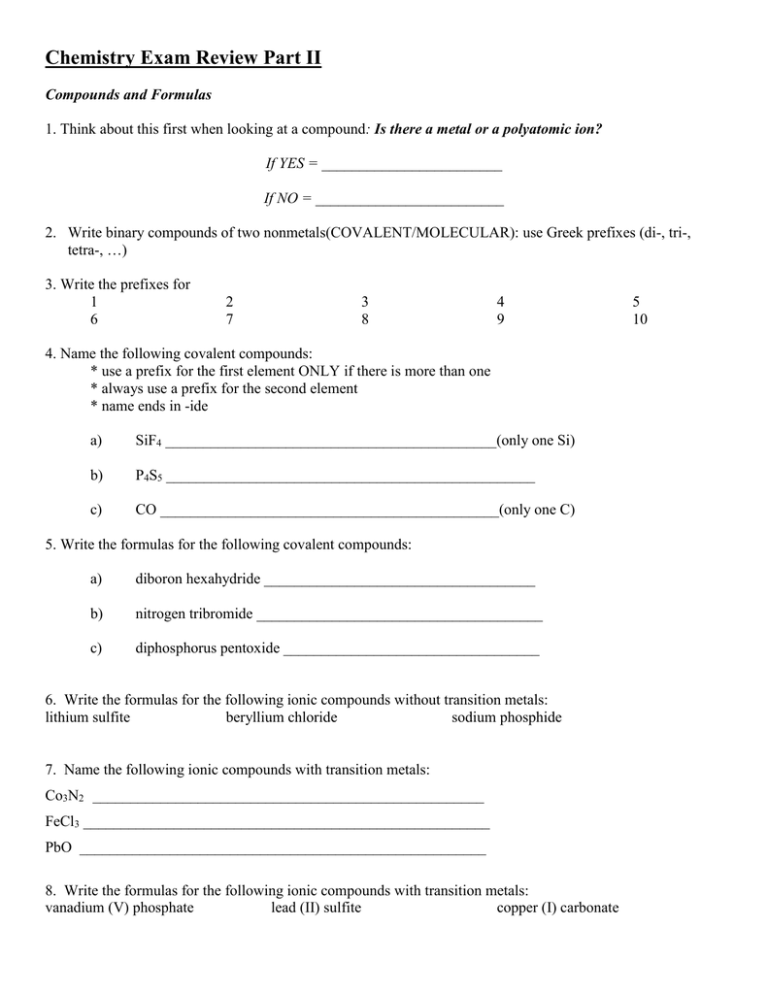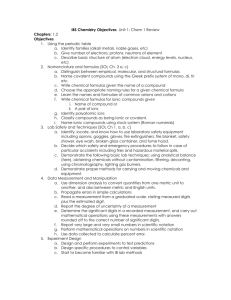Review#2
advertisement

Chemistry Exam Review Part II Compounds and Formulas 1. Think about this first when looking at a compound: Is there a metal or a polyatomic ion? If YES = ________________________ If NO = _________________________ 2. Write binary compounds of two nonmetals(COVALENT/MOLECULAR): use Greek prefixes (di-, tri-, tetra-, …) 3. Write the prefixes for 1 6 2 7 3 8 4 9 4. Name the following covalent compounds: * use a prefix for the first element ONLY if there is more than one * always use a prefix for the second element * name ends in -ide a) SiF4 ____________________________________________(only one Si) b) P4S5 _________________________________________________ c) CO _____________________________________________(only one C) 5. Write the formulas for the following covalent compounds: a) diboron hexahydride ____________________________________ b) nitrogen tribromide ______________________________________ c) diphosphorus pentoxide __________________________________ 6. Write the formulas for the following ionic compounds without transition metals: lithium sulfite beryllium chloride sodium phosphide 7. Name the following ionic compounds with transition metals: Co3N2 ____________________________________________________ FeCl3 ______________________________________________________ PbO ______________________________________________________ 8. Write the formulas for the following ionic compounds with transition metals: vanadium (V) phosphate lead (II) sulfite copper (I) carbonate 5 10 9. Name the following ionic compounds without transition metals: K2CO3 _____________________________________________________ Al(CN)3 ____________________________________________________ Li3PO4 _____________________________________________________ 10. Know names and formulas for these common laboratory acids: HCl, HNO3, H2SO4, HC2H3O2, (CH3COOH) Chemical Reactions 1. Label the following equations as either: single replacement, double replacement, neutralization, synthesis, decomposition, or combustion. a) b) c) d) e) f) H2 + Cl2 HCl ___________________________ Al + Fe2O3 ___________________________ Ba(ClO3)2 BaCl2 + O2 ___________________________ Iron (III) oxide + magnesium magnesium oxide + iron ___________________________ Hydrochloric acid + sodium hydroxide sodium chloride + water______________________ CH4 + O2 CO2 + H2O ___________________________ 2. Predict the products. a) Zn + O2 b) CaH2 + H2O c) Mg + CaCl2 d) Na2CO3 e) NH4Cl + AgNO3 f) Cu + FeSO4 3. Balance. a) ___ NO2 + ___ H2O ___ O2 b) ___Fe + c) ___ Al + ___ F2 ___ HNO3 + ___ NO ___ Fe2O3 ___ AlF3 4. Write the symbol used in chemical equations to represent the following: a) aqueous solution b) heated c) reversible reaction d) a solid e) a gas f) a liquid 5. CaO is an ingredient of cement mixes. When water is added it heats up and calcium hydroxide forms. a) Is there any evidence a chemical reaction has taken place? b) List 4 indicators of a chemical change. 6. A student heats a substance in a test tube. A glowing splint is placed over the opening to the test tube and it reignites. What is one possible product created by the heating of this substance? 7. During a demonstration a teacher extinguishes a burning splint by placing it near a beaker containing baking soda and vinegar. What did this reaction produce that extinguished the flame? 8. When a glowing splint is placed near a beaker of HCl and Zn, an audible “pop” sound is heard. Which product caused this sound to be made? 9. Write and balance the net ionic equation CaCl2(aq) + 2AgNO3(aq) → 11. What is the net ionic equation for a neutralization reaction?



